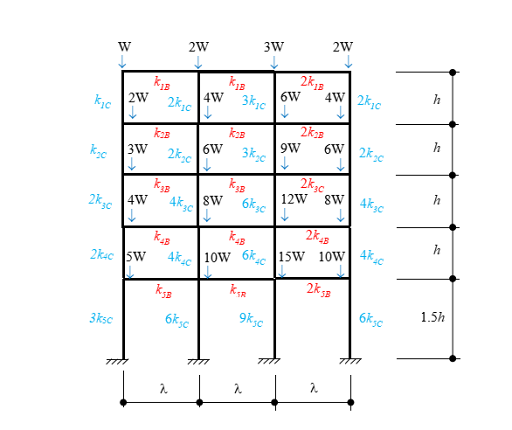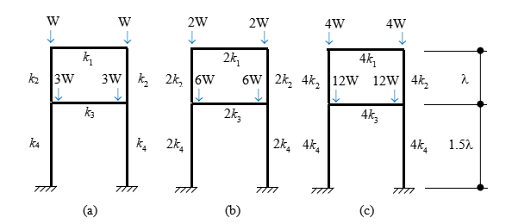| University | Singapore Institute of Technology (SIT) |
| Subject | CVE6001 - Structural Stability And Dynamics |
Abstract
An assessment is made between the bucking of a multi-bay, multi-storey frame structure with rigidly jointed connections, resulting from changes in frame geometry requested by the client. A stability analysis approach is adopted, using s and c functions or n and o functions, for various substitute frames. These are based on the principal of multiplies, including the Grinter frame approach commonly used in design practice.
Introduction
Figure 1 shows a multi-bay, multi-storey steel frame structure in which the loading, and members properties are as labelled, and all connections are fully rigid. The frames are braced out-of-plane. Column bases are assumed to form fully rigid foundations. The frame conforms to the principal of multiplies hence it can be analysed using a suitable substitute frame.
The span lengths of beams, l, are ?m, the column heights, h, are ?m and the beam properties are IiB = ?IiC, at each storey level i. The critical load of the structure is found to be W = ?p2EI/l2.

Figure 1 – Frame geometry.
Hire a Professional Essay & Assignment Writer for completing your Academic Assessments
Native Singapore Writers Team
- 100% Plagiarism-Free Essay
- Highest Satisfaction Rate
- Free Revision
- On-Time Delivery
Procedure
Systematic stiffness matrix methods
A stiffness matrix method approach is adopted, using s and c stability functions, or n and o stability functions for various substitute frames, including the well-know Grinter frame.
Explain the principle of multiples and demonstrate that the problem given conforms to the principle to which the various substitute frames and then applicable.
The stiffness matrix formulations for the various substitute frames are compared in Eqns (1) – (?), together with associated illustrations in Fig. 2.

Figure 2 – Illustration of Principle of Multiples applied to the frame given.
The frame can be obtained by fastening together p frame(s) with configuration (a), q frame(s) with configuration (b) and r frame(s) with configuration (c), which are situated side by side in the appropriate way.
Figure 3 – Comparison of substitute frames.
The numerical calculations are programmed into a spreadsheet, but the numerical results are summarised here, in full, for the various frame substitute frames adopted.
Stuck with a lot of homework assignments and feeling stressed ? Take professional academic assistance & Get 100% Plagiarism free papers
Need help with your CVE6001 - Structural Stability and Dynamics assignment? Our assignment help in Singapore offers you expert assistance. Pay someone to do your assignment for me and enjoy affordable, high-quality services with 100% human-written assignments—no AI involved! We ensure A+ results, guaranteed on-time delivery, and plagiarism-free content. Get reliable homework help online from our dedicated team!
Looking for Plagiarism free Answers for your college/ university Assignments.
- Workplace Risk-Based Assessment 1: Evaluation of Hazards, Accidents, and Safety Compliance
- SRM Reflective Assignment 2: Applying Gibbs Model to Overcome Workplace Report Challenges
- ACLP M1P TAE Written Assignment: Skills Framework & Lesson Plan Design Using Gagne’s and Kolb’s Models
- EGH222 Healthcare Analytics Assignment 2: Predictive Model for Sick Days Based on Employee Demographics and Lifestyle Data
- Sustainability Strategy Assignment: Selected Company Case Study on Addressing Sector Challenges and Driving Behavioural Change Campaigns
- 7WBS2012 Executive Career Development Assignment: Career Pathway & Readiness Post-MBA in Education Management
- CVE2322 Gantry Build Prototype Assignment: Sustainable Civil Engineering Model Using Recyclable Materials
- BMG706 Strategic Quality Change Assignment Report: Enhancing Operational Excellence at any Organization
- CVE2323 Structural Analysis Assignment: Matrix Method & STAAD.Pro Evaluation of Frame Systems
- BMK3015 Major Project Assignment: Customer-Centric Design Solutions Using Research & Project Management

